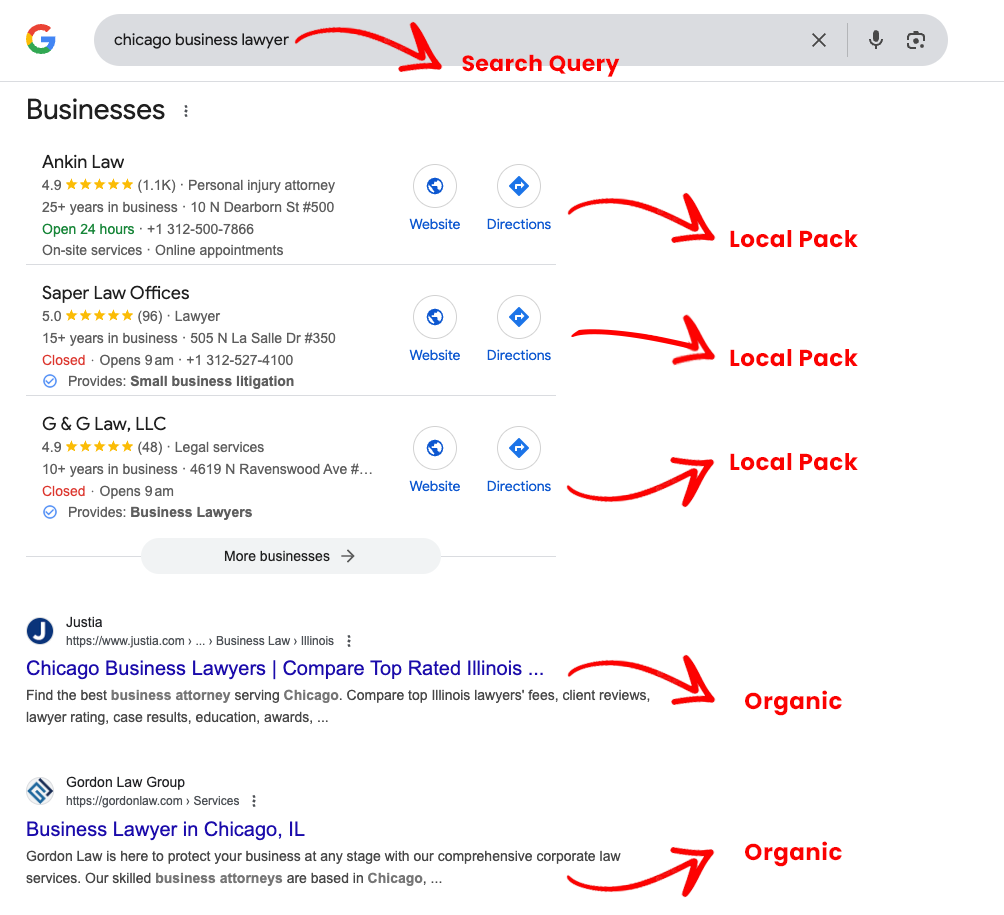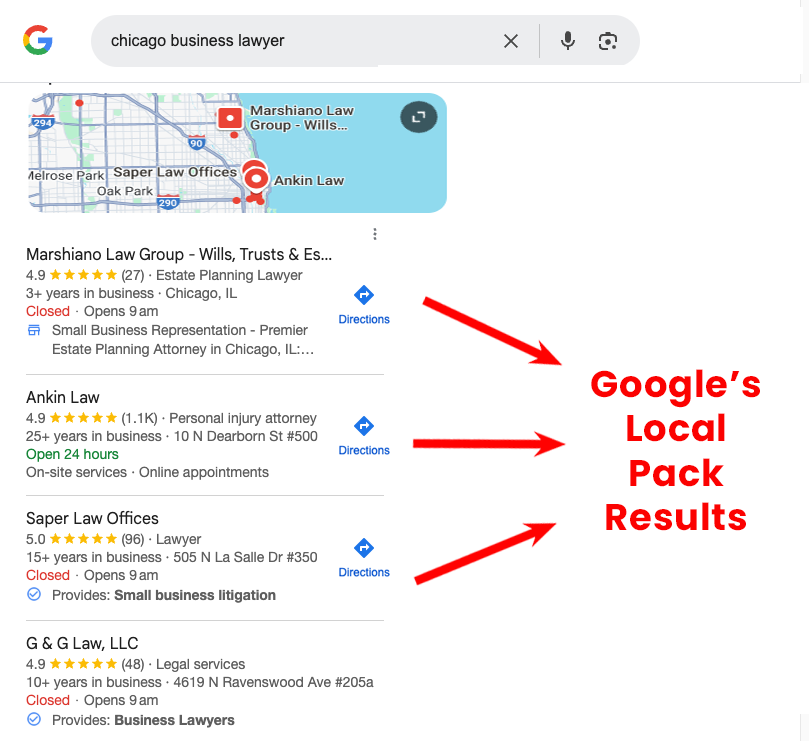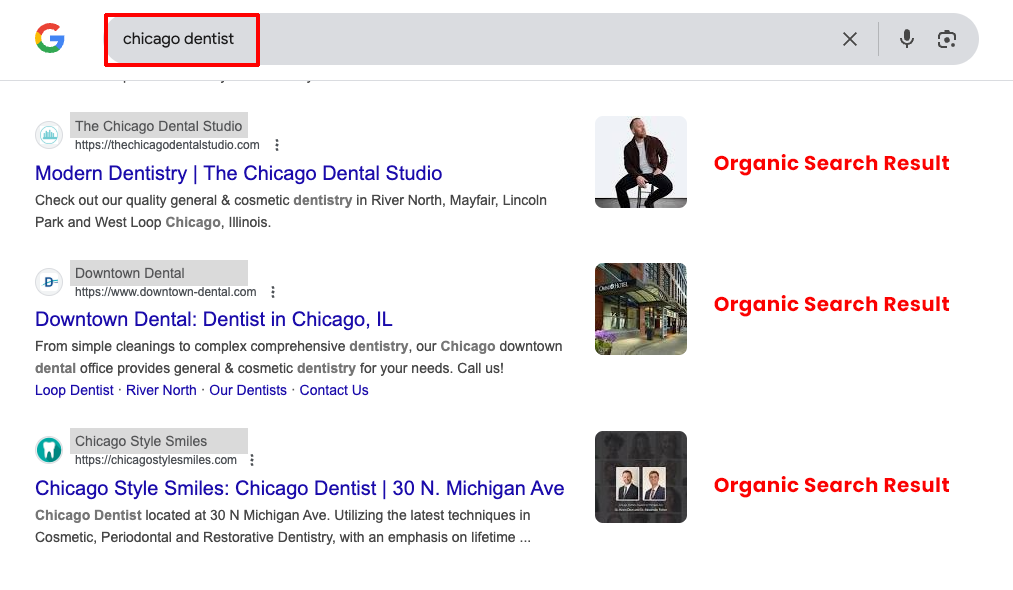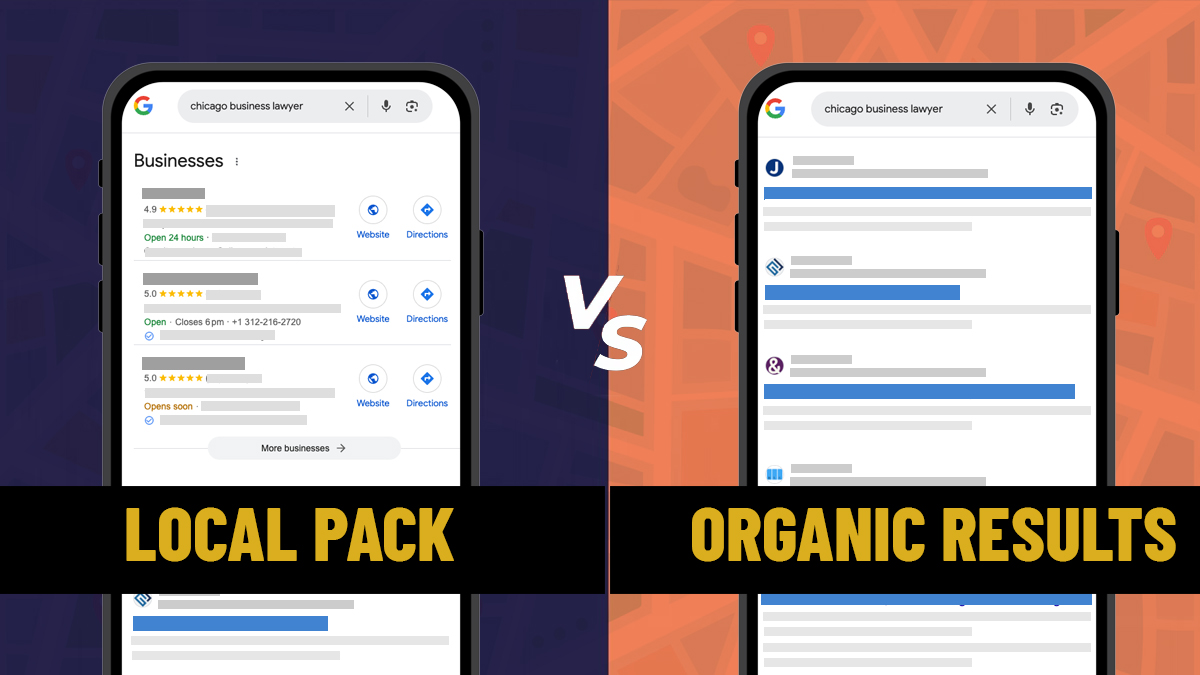Search engine optimization (SEO) is the backbone of digital marketing, helping businesses secure rankings on platforms like Google. Map Pack and organic results are essential for search results, each serving specific purposes. Map Pack focuses on local visibility, while organic results highlight content relevance and authority. Both require distinct strategies to maximize their effectiveness and drive traffic.
Map Pack rankings primarily benefit businesses targeting local customers by showcasing essential details like location, reviews, and contact information. Optimizing Google Business Profiles, maintaining consistent NAP (Name, Address, Phone) details, and earning positive reviews significantly boost Map Pack visibility. This localized approach ensures businesses are easily discoverable, catering to users searching for nearby products or services with quick, actionable options.

Organic results, on the other hand, focus on broader audience reach through high-quality content, keyword optimization, and strong backlinks. Prioritizing mobile-friendly designs, improving page load speed, and ensuring content aligns with user search intent help boost organic rankings. A strategic mix of local pack vs organic results strategies can ensure businesses capture diverse audiences, enhancing both local and global reach.
Experienced Google Maps SEO marketing services providers leverage their skills & expertise to ensure higher rankings for your local business.
Understanding Google Map Pack vs Organic Results
What is The Map Pack
The Map Pack, also called the “Local Pack” or “3-Pack,” is a vital feature in Google’s search engine that shows the top three local businesses related to a user’s search. These results appear right above the organic listings on the search results page (SERP), usually with a map. This prime spot gives businesses instant visibility to users looking for local services.

The businesses featured in the Map Pack are selected based on factors like proximity, relevance, and prominence. Google uses these criteria to ensure that users see the most appropriate and reliable local results. For businesses, appearing in the Map Pack significantly increases visibility and the likelihood of attracting potential customers. This is especially important as local search traffic continues to rise.
To improve the chances of being included in the Map Pack, businesses must optimize their Google Business Profile (GMB) listing. Ensuring accurate business details, gathering positive reviews, and maintaining consistent local citations are all essential 3-Pack ranking strategies. With local SEO becoming increasingly important, businesses focusing on these factors will more likely secure a spot in the Map Pack and boost their local online presence.
Important Features of the Map Pack
- The map shows business locations, making it simple for users to find nearby spots. This visual guide helps customers quickly pinpoint businesses, offering convenience for both locals and visitors.
- Each business listing includes key details like the name, address, contact number, hours, ratings, and a direct link to its Google Business Profile (GBP). This ensures customers easily access essential information, speeding up their decision-making.
- Businesses can improve their visibility in local searches by highlighting proximity and relevance. Being easy to find on the map boosts chances of attracting nearby customers, driving more traffic, and improving rankings.
What Are Organic Search Results
Organic results are the natural listings you see below paid ads and the Map Pack in search engine results pages (SERPs). Paid promotions don’t influence these rankings; they come from how well a website ranks naturally. Organic results are key for businesses to gain lasting, sustainable visibility on search engines without constantly paying for ads.

The ranking of organic results depends on search engine algorithms, which look at factors like content relevance, keyword optimization, and backlinks. These algorithms focus on how well a webpage matches a user’s search intent, favoring high-quality, helpful, and authoritative content. Websites that provide value and meet user needs are more likely to rank higher in organic search results.
Unlike paid ads, organic results provide steady visibility over time. Getting a strong organic ranking takes continuous SEO work, like improving site speed, optimizing for mobile, and refining content. This strategy helps build trust and credibility, leading to better user engagement and higher conversion rates—without relying on ongoing advertising costs.
Important Features of the Organic Results
- Primarily text-based, with occasional rich snippets or schema-enhanced results (e.g., FAQs or product reviews). Rich snippets, powered by schema markup, enhance visibility by showing detailed content like FAQs or reviews in search results, improving click-through rates and user experience.
- Focuses on website authority, backlinks, content quality, and on-page SEO. Website authority is built through quality backlinks, site trustworthiness, and performance. High-quality, user-intent-driven content and optimized on-page SEO (meta tags, headings) boosts visibility and search engine rankings.
- Targets a broader audience, not limited to a specific area. Broader SEO strategies capture many search queries, helping businesses reach a larger audience across diverse industries and locations. These strategies often target competitive keywords to attract varied visitors.
Factors That Affect Rankings In The Google Map Pack And Organic Results
How to Improve Your Map Pack Rankings
- Proximity: The physical closeness of a business to the searcher significantly impacts local SEO rankings. Businesses near the user’s location are more likely to appear in search results, especially for queries like “near me.” Leveraging location-targeting based keywords and ensuring accurate Google maps placements can boost proximity-based visibility.
- Relevance: This reflects how well a business aligns with a searcher’s intent. Tailoring services, products, and website content to specific keywords enhances relevance. For example, incorporating targeted descriptions in Google Business Profile categories can improve your chances of matching user queries.
- Prominence: Prominence highlights a business’s reputation and trustworthiness online. Factors like positive reviews, consistent backlinks, and mentions in credible sources improve rankings. Actively managing reviews and earning quality links from local websites or directories can elevate your prominence.
- Google Business Profile Optimization: Accurate and comprehensive Google Business Profile details are essential. Regularly updating hours, contact information, and services ensures trust. Adding high-quality photos and responding to customer reviews further strengthens your profile’s appeal and search performance. Perform a competitive analysis to ensure proper GBP optimization.
- Citations: Consistency across all listings is vital for local SEO. Matching your business Name, Address, and Phone Number (NAP) across platforms like Yelp and Bing builds credibility. Tools like Moz Local or BrightLocal can help monitor and ensure citation accuracy.
Factors That Impact Organic Rankings
- Content Quality: Content should be engaging, well-researched, and strategically optimized with keywords. Visuals like images and infographics enhance readability and audience retention, ensuring a perfect blend of user engagement and improved search engine rankings for maximum effectiveness.
- Backlinks: Building backlinks with credible, industry-relevant websites enhances authority, credibility, and rankings. Ethical link-building strategies, like guest posts or collaborations, ensure a strong link profile that complies with search engine guidelines while driving quality traffic to the site.
- On-Page SEO: Effective on-page optimization includes refining meta titles, headers, URLs, and alt tags while integrating keywords strategically. These efforts ensure better search engine rankings and user experience, making content more accessible and discoverable to the target audience.
- User Experience (UX): Seamless user experience focuses on fast-loading pages, mobile-friendly layouts, and intuitive navigation. These elements keep users engaged longer, improve trust, and increase the likelihood of conversions, creating a hassle-free and enjoyable browsing experience.
- Engagement Metrics: Enhancing engagement involves encouraging clicks, reducing bounce rates, and increasing time on site through compelling content and interactive elements. These strategies improve user satisfaction and lead to better overall performance and conversions.
Why Both Are Crucial For Your Business
Map Pack
- Local Dominance: Local dominance boosts visibility for brick-and-mortar businesses in local searches, helping drive foot traffic and service calls. Optimizing for local SEO ensures businesses appear in local packs, map listings, and geo-targeted ads, attracting nearby customers seeking immediate services.
- High Visibility: High visibility on search engine results captures mobile and local searchers’ attention. Being positioned at the top increases your chances of attracting customers ready to take immediate action, whether by visiting, calling, or purchasing, especially with mobile search usage.
- Trust Factor: Positive reviews and high star ratings build trust and credibility, influencing potential customers’ decisions. A strong online reputation with consistent, positive feedback serves as social proof, reassuring customers and boosting the likelihood of conversion and long-term loyalty.
Organic Results
- Wider Reach: Expanding beyond regional boundaries helps businesses connect with national and international audiences, increasing visibility. This broader exposure is essential for scaling operations and tapping into diverse markets.
- Trust and Credibility: A strong online presence, backed by positive reviews and reliable information, solidifies a brand’s reputation. Building expertise through quality content and consistent engagement fosters trust, ensuring long-term customer loyalty.
- Consistent Traffic: Regular website visits are vital for sustained engagement. Leveraging SEO strategies like optimized content and backlinks can drive steady traffic, boosting interaction and conversions over time.
Appearing in both localized Map Pack searches and broader organic results helps businesses align with multiple search intents, including nearby service queries and purchase-ready searches, maximizing their online impact.
Ways To Boost Your Map Pack Rankings
Optimize Your Google Business Profile
- Complete Business Info: Ensure accurate NAP details, operating hours, and business descriptions. Consistency across platforms improves local SEO and user experience.
- Choose Relevant Categories: Select precise business categories and subcategories to improve search visibility and attract the right audience.
- Upload Quality Images: Map Pack image optimization is important. Post high-resolution images that showcase your products, services, or premises. High-quality visuals enhance trust and user engagement, improving SEO performance.
Focus on Reviews
- Requesting feedback from satisfied customers is essential for building trust and improving your business. Positive reviews provide valuable social proof that can influence potential clients. Encourage clients to share their experiences and offer incentives to increase participation.
- Responding to every review, regardless of its sentiment, demonstrates your commitment to customer satisfaction and shows that you value feedback. Acknowledging both positive and negative reviews helps maintain a transparent and trustworthy brand image.
- Feature client testimonials in your marketing materials, including social media, website, and advertisements, to boost credibility and attract new customers. Real customer experiences resonate with potential clients, creating a sense of reliability and trustworthiness around your brand.
Leverage Local SEO
- Include regional keywords in your Google Business Profile and website: Make sure to use local keywords like your city, neighborhood, or nearby landmarks. This helps your business appear in local searches, making it easier for people nearby to find you.
- Apply structured data for local businesses: Implement schema markup to provide search engines with essential details like business hours, location, and contact info, boosting your chances of appearing in rich snippets and improving local SEO.
- Ensure your business is featured in key directories like Yelp and TripAdvisor: List your business on reputable platforms like Yelp and TripAdvisor to build credibility, increase visibility, and improve local SEO by attracting potential customers and reviews.
Consistent NAP Information
- Ensure your business name, address, and contact number (NAP) are consistent across all platforms, including your website, social media, and directories like Google My Business and Yelp, to build trust and improve SEO.
- Immediately correct any inaccurate or outdated listings. Regularly monitor and update your information using tools like Moz Local and Yext to maintain consistency, improve visibility, and make it easier for customers to reach you.
Mobile Optimization
- Optimize your website for speed by compressing images, using caching, and minimizing files. Ensure mobile compatibility with a responsive design, as most local searches happen on mobile devices, enhancing user experience.
- Include clickable phone numbers and clear directions on your site. This provides easy access for local users to contact you and find your location, improving engagement and increasing conversions.
Ways To Boost Organic Results
Develop a Content Strategy
- Create Content That Matters: Write blog posts that truly speak to your audience’s needs. Dive deep into topics, doing your research to tackle their pain points and interests. Tools like Google Analytics and SEMrush can help you discover what’s really resonating with your readers.
- Include a combination of long-tail and short-tail keywords: Use both short-tail and long-tail keywords to boost search visibility. Short-tail keywords drive traffic, while long-tail keywords attract targeted visitors, improving conversion rates and SEO rankings.
- Frequently refresh your content to maintain its relevance: Regularly update it with fresh information to maintain relevance for users and search engines. Refresh old posts and repurpose content to improve rankings and engagement.
Technical SEO
- Page Speed Optimization: Optimize page speed using tools like Google PageSpeed Insights. Ensure mobile responsiveness for better user experience and engagement. Simplify your layout to enhance navigation and reduce bounce rates.
- Schema Markup Implementation: Add schema markup to improve content visibility in search results with rich snippets, increasing click-through rates. Use structured data from Schema.org for better understanding by search engines and users.
- Regular Site Audits: Use tools like Screaming Frog or Ahrefs to identify broken links and errors. Fix issues with redirects or removals to improve user experience and maintain SEO performance. Regular audits keep the site optimized.
Backlink Building
- Obtain authoritative backlinks through guest blogging, collaborations, and public relations. These strategies help you secure high-quality links from trusted sources, improving credibility and boosting your site’s SEO performance.
- Focus on securing industry-specific backlinks. Relevant links from authoritative industry sources enhance your site’s credibility, attract the right audience, and improve search engine rankings by showing your content is valuable and trustworthy.
User Experience
- Simple Layout: A clean, organized layout with logical structure and clear menus helps users find what they need quickly, improving engagement and reducing bounce rates, ensuring a seamless user experience.
- Effective CTAs: Strategic, compelling CTAs guide users to take action, such as signing up or purchasing. Action-oriented language and testing variations can increase conversions and optimize user engagement across your website.
- Accessibility Focus: Ensure your website is accessible by using alt text, screen reader compatibility, and high contrast for readability. Accessible sites enhance user experience, expand audience reach, and improve SEO performance.
Engage Your Audience
- Leverage analytics tools to pinpoint top-performing content and replicate its effectiveness. Use platforms like Google Analytics and SEMrush to track traffic, engagement, and shares, then replicate successful content strategies to maximize results.
- Foster social interactions and shares to extend your content’s reach. Encourage sharing on platforms like Facebook and LinkedIn, use tools like Buffer for scheduling, and engage with your audience to boost visibility and organic reach.
Connecting The Dots With Tactics For Both
Unified Keyword Research
- Use keywords to target local Map Pack and broader organic search traffic. For local reach, phrases like “HVAC repair near me” or “24/7 HVAC service [city]” are ideal for capturing nearby customers seeking urgent help.
- For broader visibility, use terms like “top HVAC companies” or “best air conditioning repair services.” These keywords appeal to users researching reputable providers, helping your business stand out among competitors while building trust and authority online.
- Long-tail keywords like “affordable AC maintenance near me” or “quick furnace repair [city]” can also be effective. These terms address specific needs and improve your chances of appearing in both local and organic search results, boosting reach.
Cohesive Branding
- Keep your branding consistent across your GBP, website, and social media. When your logo, colors, and messaging match everywhere, it makes your business instantly recognizable. People like to see something familiar—it helps strengthen your brand.
- Consistency also builds trust. Customers feel more comfortable with brands they can recognize, and when your look and message are the same across platforms, they’re more likely to engage. It makes you appear dependable and professional.
- By staying consistent, you also improve your online presence. Whether someone finds you on Google or scrolling through Instagram, they’ll know it’s you. This makes you more memorable and helps create a stronger connection with your audience.
Track Performance
- Leverage tools like Google Analytics and GBP Insights to monitor traffic and engagement. Google Analytics offers detailed reports on user activity, providing insights into where visitors come from and how they interact with your site.
- GBP Insights focuses on how users engage with your business on Google. It highlights search queries, location data, and the number of views, helping you understand what drives local traffic and customer interest in your services.
- By continuously reviewing these insights, you can make adjustments to your strategies. If certain content or keywords are underperforming, you’ll know exactly where to optimize for better engagement and improved results moving forward.
Leverage Reviews in Content
- Showcasing positive customer reviews on your website is a powerful way to boost organic SEO. Google prioritizes user-generated content, and reviews are a key ranking factor. When you highlight positive feedback, it signals to search engines that your business is credible and trustworthy.
- Displaying reviews also increases trust with potential customers. Seeing real experiences from others reassures visitors and builds confidence in your products or services. This trust can increase engagement and conversion rates, making your website more attractive to potential clients.
- Additionally, reviews can improve your business’s visibility in the local Map Pack. Google considers local reviews when determining rankings for map results. The more positive feedback you show, the higher your chances of being featured in local searches, driving more traffic to your site.
Common Mistakes To Watch Out For
Ignoring mobile users is a critical mistake for any business today. Mobile optimization is not optional anymore; it’s essential for SEO. With most internet traffic coming from mobile devices, websites that aren’t mobile-friendly risk losing a significant portion of their audience. Google prioritizes mobile-friendly sites, so if your site isn’t optimized for mobile, you’ll likely see lower rankings and fewer potential customers.
Inconsistent NAP (Name, Address, Phone Number) details can severely harm both your local rankings and Map Pack visibility. Google relies on accurate business information to verify your presence online. If there are discrepancies across different platforms, search engines get confused, and your credibility drops. Consistency in your NAP information across all online directories, reviews, and social profiles is crucial for maintaining strong local SEO performance.
Neglecting reviews is another major mistake that impacts both customer trust and SEO. Positive reviews directly affect your rankings in the Map Pack and other local search results. They provide social proof that boosts credibility and influences potential customers. Responding to reviews shows you care about feedback, helping you maintain a strong online reputation and ensuring that your business stays visible to search engines and prospective clients.
Conclusion
Understanding the differences between Map Pack’s and organic results is crucial for building a successful SEO strategy. While Map Pack results are location-specific and offer immediate visibility, organic results rely on broader factors like content quality and backlinks to drive long-term rankings. To maximize visibility in both, businesses should optimize for local SEO by improving their Google My Business listing and also focus on traditional SEO techniques, such as keyword optimization and content creation, to enhance their organic search performance. By balancing these strategies, businesses can improve their overall online presence and attract more traffic.
FAQs
How can businesses optimize for Map Pack visibility?
To optimize for the Map Pack, businesses should focus on local SEO, including optimizing their Google My Business (GMB) profile, ensuring consistent business details across platforms, and encouraging positive reviews. Additionally, creating localized content, using local keywords, and local backlinks can improve relevance and increase chances of appearing in the Map Pack.
How can a business prioritize between Map Pack and organic SEO efforts?
The priority depends on a business’s goals. Local businesses targeting nearby customers should focus on Map Pack SEO for immediate results. However, investing in organic SEO is crucial for long-term growth or broader reach. A balanced approach—optimizing for both Map Pack and organic SEO—ensures comprehensive visibility, reaching local and global audiences.
Why is it important for businesses to focus on both Map Pack and organic SEO?
Focusing on both SEO strategies enhances overall visibility. Map Pack results drive local, immediate traffic, while organic SEO builds long-term online presence. By optimizing for both, businesses can capture local and broader audiences, increasing their chances of success in search results and reaching more potential customers.
How can local businesses monitor their performance in the Map Pack and organic results?
Businesses can use Google Search Console and Google Analytics to monitor organic performance, including keyword rankings and traffic data. For Map Pack performance, tools like BrightLocal and Moz Local provide insights into local rankings and Google My Business data. Regular monitoring helps businesses assess their strategies and make improvements for better visibility.
























